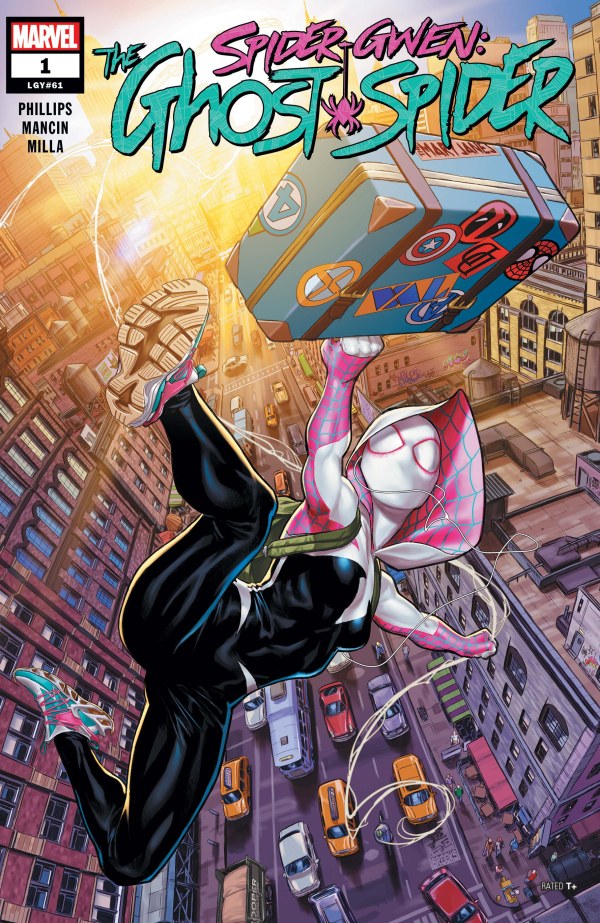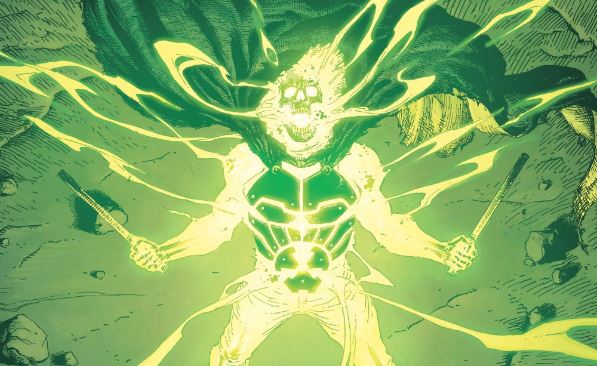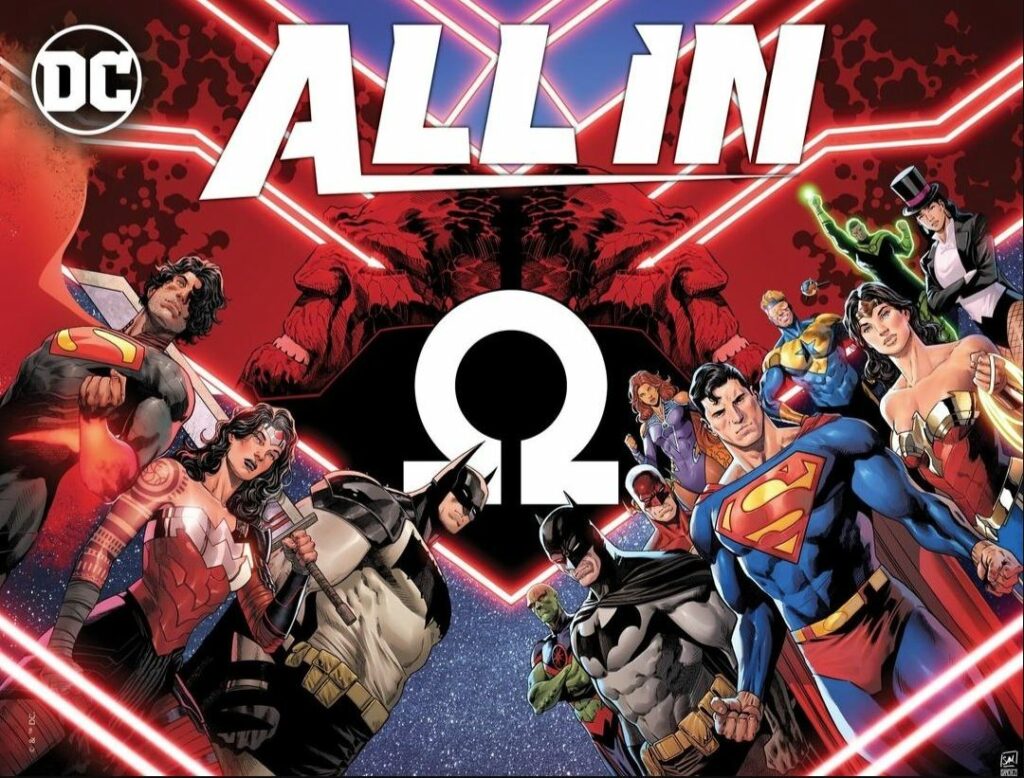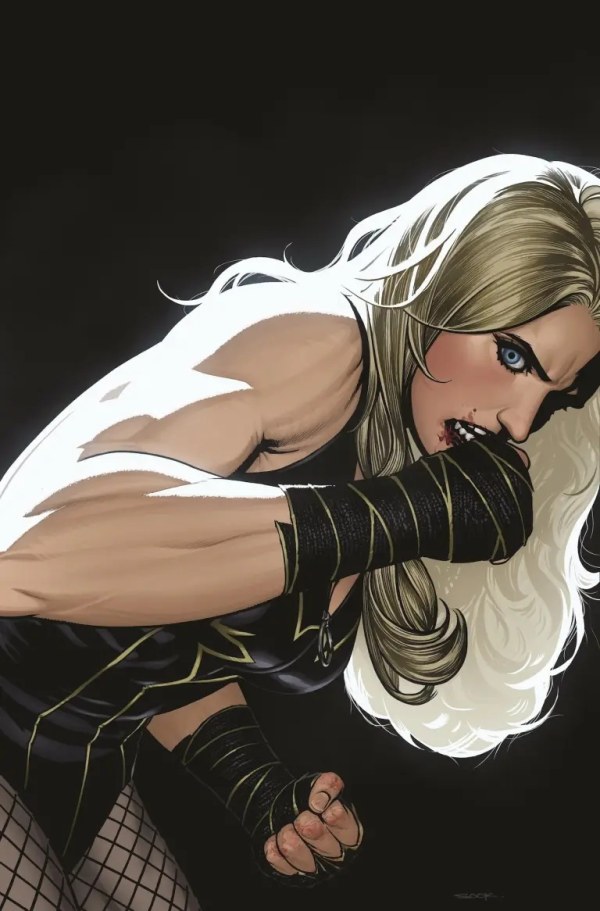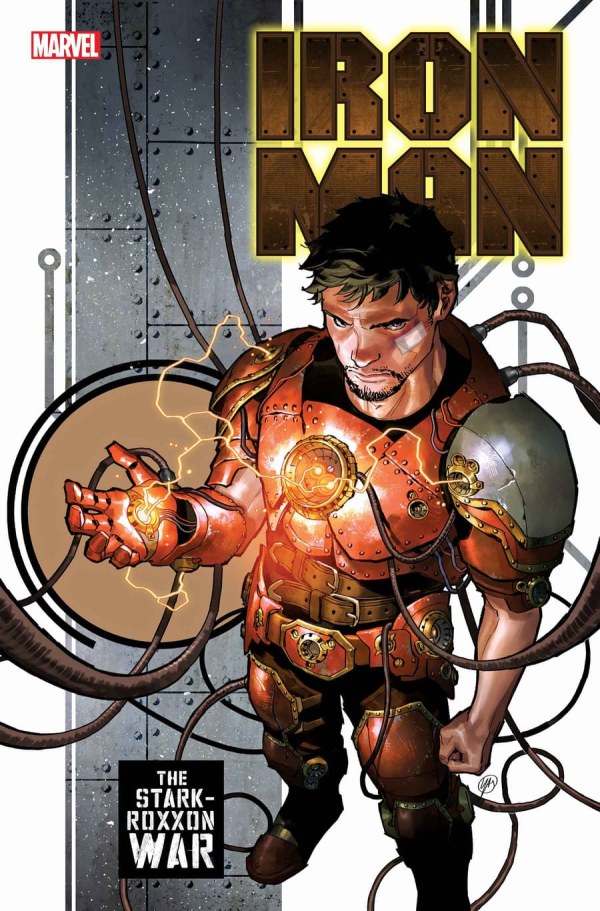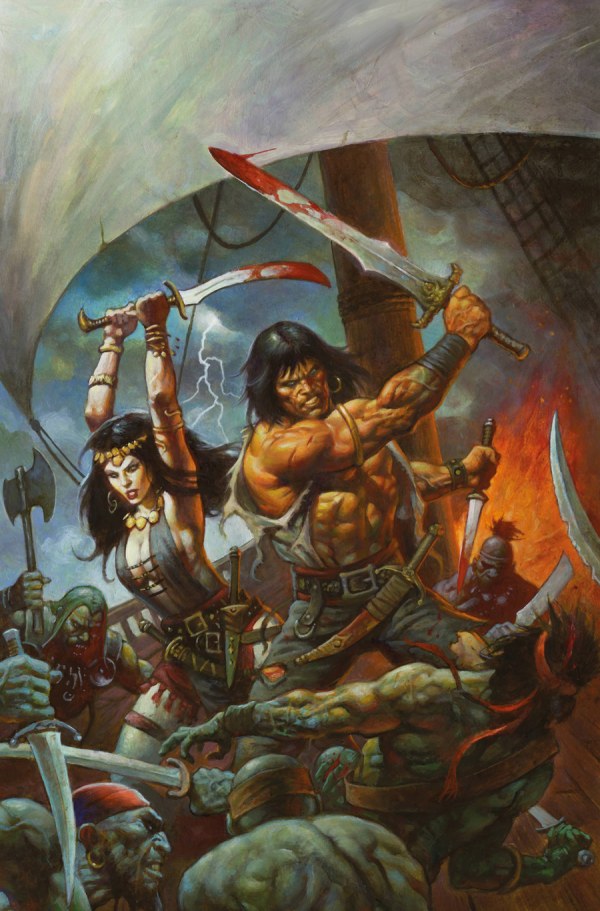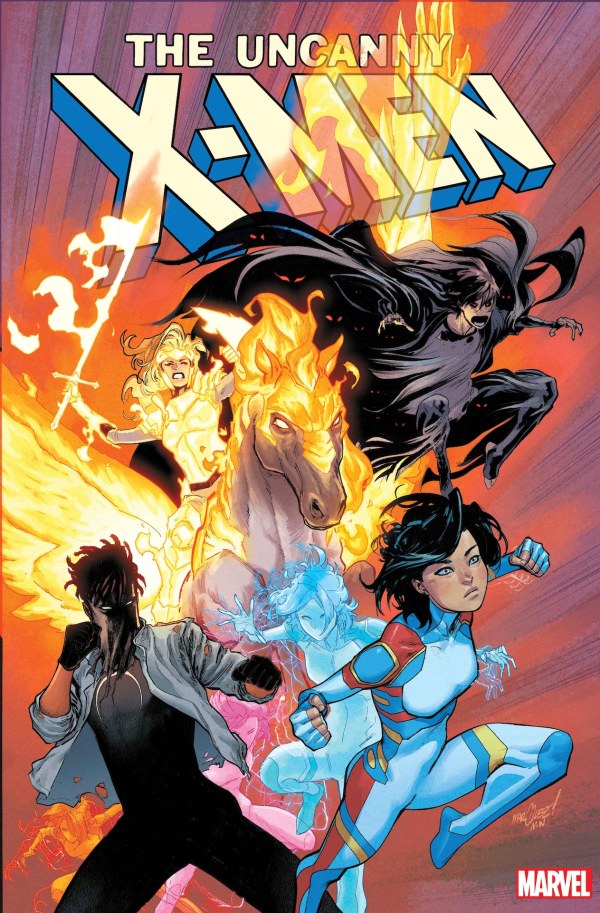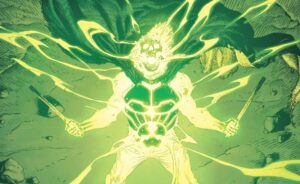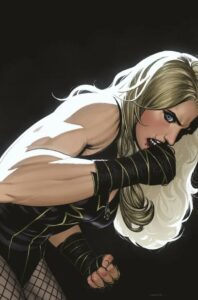Gwen Stacy – that is, the Gwen Stacy of Earth-65 – has become something of a cultural phenomenon among younger generations of readers and viewers.
With her debut as Spider-Gwen in Edge of Spider-Verse #2 way back in 2014, readers flocked to her innovative design and strong personality. Since then, she’s helmed multiple series, starring in 60 issues of ongoing series as well as multiple mini-series, and has headlined in seemingly just as many Spider-adjacent events. Couple that with the phenomenal success of the Spider-Verse animated movies, and Spider-Gwen’s impact on the fanbase has only grown exponentially over time.
However, despite that popularity, there has been an air of uncertainty surrounding the character for the last few years. Where once she carried a 34-issue long solo-series even in a very risk averse market, she’s more recently been confined to limited runs, flitting between status quos.
So, when the new ongoing series was announced with Spider-Gwen: The Ghost Spider #1, the atmosphere on the ground was split.
Equal parts excitement and trepidation proliferated online discourse. Some Spider-Gwen fans were overjoyed to see a new series on the stands, especially one with a potentially unlimited runway. Others were frustrated. Gwen is, for many, at her best when situated on her home world of Earth-65, and this new series was set to do away with that.
With that in mind, Stephanie Phillips (Harley Quinn, Black Widow & Hawkeye) and artist Federica Mancin had a world of expectations to meet. They needed to craft something worthy of carrying on the legacy of one of the most successful new characters in comics. They needed to establish their own style and voice, without veering too far from the very work before them that made Spider-Gwen so beloved in the first place. They also needed to justify this controversial new status quo. And they had to do all of that while delivering 30 pages of character, action and plot unburdened by the context of everything so that you’re left wanting to come back next month for more.
All those expectations, and somehow, they’ve met them.
Finding Where You Belong
There are at least 10 different Spider-characters running around Marvel-616, and most of them live in New York. Adding another to that, especially when they have such a vibrant and unique home turf to tell stories in, raises questions of redundancy.
It’s to Phillips’ credit then that not only does she address this almost immediately in Spider-Gwen: The Ghost Spider #1, she builds upon it. By weaving this element into Gwen’s journey, she serves both the character and the metatextual dimensions of the story.
First, Phillips quickly, and astutely, lays out the groundwork for this new direction. Gwen is unmoored, unable to return to her home universe and forced to find a new life on Earth-616. Enlisted in a T.V.A.-sponsored witness protection programme, she’s meant to be laying low, assuming a new identity and avoiding being noticed by the superhero (and villain) community.
It would have been easy enough to spin a typical young-adult yarn of burgeoning identity and a feeling of uncertainty with one’s place in the world out of this setup. And while this issue does play on those familiar tropes, Phillips and Mancin elevate things by using this framework to establish a refreshing new take on the character.
Spider-Gwen: The Ghost Spider #1 revolves around anxieties that resonate strongly, not just with me but I would wager lots of readers in its target audience. The idea that you’re living the life someone else was meant to live, leaving you feeling like you’re haunting your own experience. The feeling that no matter how ill that suit fits, the world is telling you that it’s the one you’re stuck with, and you better make the most of it cause that’s what you get. That trying to be the person you want to be, the person you know you should be, is going to have consequences and you’re not ready to deal with them. Probably never will be.
‘People move all the time. To new neighborhoods, new homes… change schools and make new friends. But leaving everything and everyone I know behind to move to a completely new universe…? Not even a routine bank robbery could make me feel more at home.’
Gwen Stacy, Spider-Gwen: The Ghost Spider #1 (2024)
It’s why the line ‘so I guess that makes me a ghost. A ghost from a different Earth’ works so brilliantly as an opening frame for the issue. Emotionally it opens up an entire narrative arc for Gwen to go on that both operates comfortably within the genre conventions but also plays with them in ways we rarely get to see, either in Young Adult fiction or Spider-Verse stories. It also operates on a meta level, giving new meaning to the name Ghost Spider that does more to contextualise it in two lines that we’ve had in years.
And, on top of all that, it recognises one of the most important parts of superhero comics, which is the need to bridge the gap between the fantastical and the mundane.
That is, superhero stories work at their highest level when the most imaginative, most audacious parts are used not just as aesthetic but as a layered storytelling language. Playing the multiversal flotsam angle as that and that alone would reduce the narrative, somehow making it smaller by trying to make it larger. Instead, Phillips opts to use that cosmic scale to focus in, and in so doing actually widens the emotional scope of the series, allowing it to speak to something far more universal.
It leaves the rest of the issue in a furtive space to explore these questions of belonging in a novel way.
Utilising Gwen’s symbiote, for example – a living costume that envelopes her out of instinct when danger’s around – as a metaphor for her true self being repressed is fantastic. ‘It feels like it’s crawling under my skin,’ she remarks, ‘scratching to be let out’. It combines the superheroic with shades of body horror in a way that gestures towards a lot of those classic Young Adult themes. She is at once brimming with radical potential, and also at odds with her own body and the possibilities it possesses.
You Either Got Style, Or You Don’t
Mancin’s linework alongside Matt Milla’s colouring really supports this inherent conflict between the person Gwen is and the person she could be.
Throughout Spider-Gwen: The Ghost Spider #1, Gwen is rendered in a variety of dynamic and powerful poses. And yet, at no point does she ever feel overly-idealised. This is very much a young woman that moves with grace and strength, but who also contorts in odd ways and whose limbs can be just as lanky as they are titanium-strong.
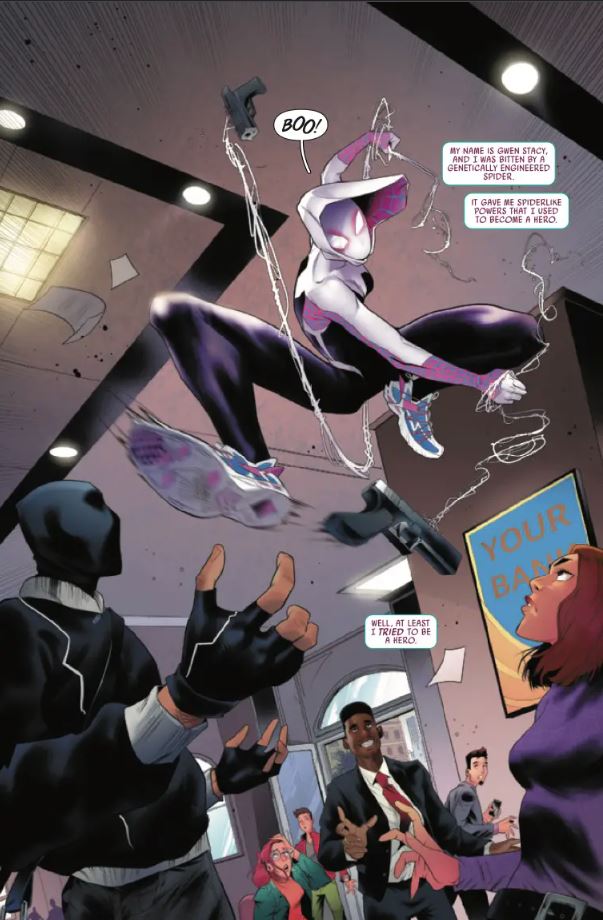
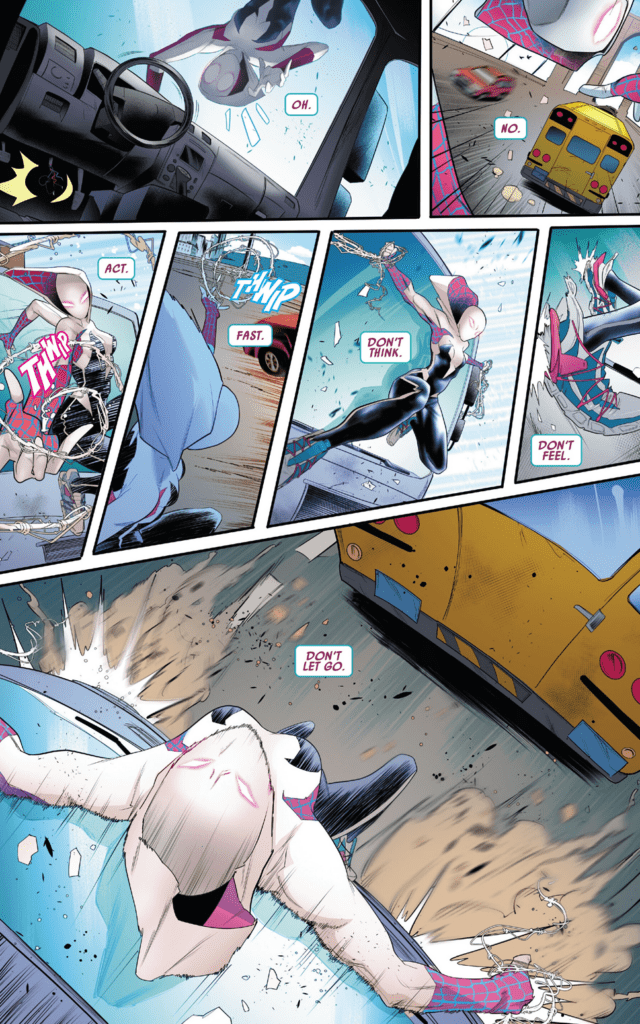
Mancin and Milla’s visual storytelling remains dynamic throughout, focusing on crafting a strong sense of personality through movement and expression that pairs well with Phillips’ script. There are some panels here and there where the perspective can look slightly off, with some limbs and heads crossing over from stylistically-exaggerated to genuinely unruly, but the overall style of the book and the strength of its best pages lift the whole thing up as a visual treat.
In particular, Milla is increasingly adept at balancing classic comics colouring techniques with the possibilities of digital tools.
I often wince at overly developed, digitally coloured work that trades readability for a misplaced emphasis on “realism”. However, Milla employs a blended style that works to Spider-Gwen: The Ghost Spider #1‘s favour. For example, while Gwen’s costume (particularly her legs) is often lit in interesting, bloom-effected ways, Milla also populates the pages with enough flat colours and simple gradients to keep everything decipherable to the eye. Backgrounds fade into the furthest planes, as they should, and Gwen always pops as the most visually interesting thing on the page. This platforms the great work Mancin’s done with Gwen’s expressions, and also helps convey her balletic sense of movement by allowing the reader to scan the pages as easily as possible.
Swinging Into a New Age
Spider-Gwen: The Ghost Spider #1 does something few comics manage in that it genuinely surprised me.
Despite my well-won love of Stephanie Phillips work on Harley Quinn and more recently on Black Widow & Hawkeye, I was sceptical about this series. Outside of the films, my interest in Spider-Gwen is fairly limited, and the baggage this book was coming in with (however unfair it is that it’s lumbered with it aside) had me tempering my expectations.
Yet I’ve come away from the issue intrigued. Gwen’s story is a relatable one, even told through a superficially unrelatable lens. The mystery around her protection under the T.V.A. is interesting, though really, it’s the personal drama that wins out, and the visual identity that the book is establishing both evokes very complimentary comparisons to artists like Federico Vicentini while also being unique enough to stand on its own.
Phillips, Mancin and Milla have crafted a refreshing new entry into Gwen Stacy’s story with Spider-Gwen: The Ghost Spider #1. The opening issue is accessible and bold, and leaves you emotionally invested enough to want to know where things are headed for Gwen’s 616 adventures.
If you’ve been on the fence, or are looking for an easy in off the back of watching the Spider-Verse movies, make sure you check this one out.


